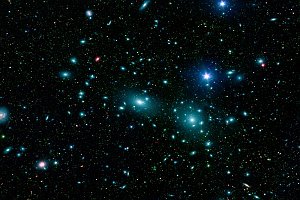 The first evidence for dark matter came from Fritz Zwicky’s observation of the Coma Galaxy Cluster. Image Credit: NASA, JPL-Caltech, SDSS, Leigh Jenkins, Ann Hornschemeier (Goddard Space Flight Center), et al.
The first evidence for dark matter came from Fritz Zwicky’s observation of the Coma Galaxy Cluster. Image Credit: NASA, JPL-Caltech, SDSS, Leigh Jenkins, Ann Hornschemeier (Goddard Space Flight Center), et al.
Dark matter (think of matter as a fancy word for stuff) is one of the most exciting but also potentially frustrating phenomena in cosmology today. It plays no detectable role on Earth in deciding how far we can throw a baseball, or determining the characteristics of the complicated materials we use to build computers. In fact the only reason we know that it exists at all is by looking through telescopes at objects so distant that it would take hundreds of millions of years to get to them even traveling at the speed of light. And yet we believe there is almost six times as much dark matter in the universe as the regular matter that we can see and feel and touch. Recent results of the Cryogenic Dark Matter Search (CDMS) may have brought us a step closer to understanding this elusive material.
Dark matter’s discovery belongs to Fritz Zwicky. Known for a bullying personality and a fondness for doing one-armed pushups in the Caltech dining hall, Zwicky also measured the Coma Galaxy Cluster in 1933, and noticed that galaxies seemed to be moving far more quickly than gravitational theory would predict. Either the theory of gravity had to be wrong, or some other hidden form of matter--dark matter--must be playing a role here. (Careful! This is not to be confused with antimatter, which stars in Dan Brown’s Angels and Demons, or with dark energy, an even more bizarre cosmological idea.)
Subsequent measurements have corroborated Zwicky’s conclusions, and today we can say with a fair degree of confidence that dark matter must exist. Still, we don’t have any idea why this is so or what dark matter might actually be.
Enter CDMS, a whopper of an experiment buried deep within the Soudan mine of northern Minnesota and consisting of a collaboration of no fewer than 18 experimental research groups scattered across the world. Some of the most promising theories predict that dark matter consists of a deluge of particles constantly washing through the distant galaxies we see, but also through our own Milky Way Galaxy and in particular through the Earth. Such particles, coined sometime in the 1980s as Weakly Interacting Massive Particles (or WIMPs), should be detectable on extraordinarily rare occasions if you can put your detector in a pristine enough location.
